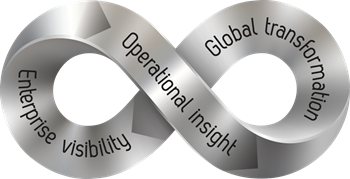We’re all familiar with
paradigms, those sets of ideas from academia, science, and business that describe ways in which we look at things, how we frame our discussions—philosophical or theoretical “frameworks,” if you will.
One of the most well-known paradigms ever was from the ancient astronomer Ptolemy: “the earth is the center of the universe.”

In the 16
th century, Copernicus challenged that notion, stating that the sun was the center of our universe, and that the earth (and other heavenly bodies) revolved around it. Later, in the 17
th century, Galileo, using his newly constructed telescope, studied the visible universe and strongly agreed with Copernicus.

Suffice it to say, without going into a whole history lesson here, that the Catholic Church, which was very powerful and influential in Galileo's day, and supported the theory of a geocentric, or earth-centered, universe (like almost everyone else at that time), accused him of heresy and ultimately sentenced him to life imprisonment.
That's how strong a paradigm can be. We may not really believe it, we may even think it's impossible, but we go along with it because of our experience, because there is a whole framework of thought and discussion behind it. Because it’s “accepted.”
However, like rules, paradigms were made to be broken. And the paradigms that have been built up around manufacturing quality are sagging under the weight of modern technology and applied statistics. And that’s what I’d like to talk about today…
Manufacturing Quality Paradigms
In all honesty, I think that the word “paradigm” has been overused in modern discourse. But in this context, when we're talking about what is possible in modern manufacturing quality today versus what has been done in the quality world in decades past, I think it’s safe to say that
it's a new deal today. So, we need to think about those manufacturing quality paradigms that are really no longer true, or even applicable.

SaaS is a Paradigm Breaker, a Game Changer
Here’s the way we used to think: If I’m going to make improvements in my manufacturing processes, then those improvements will be localized, right? That is, I can make an improvement at a production line, or for a particular product code, at a single plant…and those things take place
at the plant level.
Software-as-a-Service (SaaS) has shattered that paradigm. SaaS provides manufacturers with the capability to have
data collection and
visibility across the entirety of an enterprise. SaaS provides our quality improvement experts at the corporate level (from anywhere around the globe) to be able to sort, slice, and dice data anyway they want from across plants, across departments, across the enterprise, across regions. It just doesn't matter anymore; there are no limitations.

Quality Paradigm Broken, Now What?
So, we recognize that cloud-based quality systems enable us to completely negate any limitations we may have had in the past regarding visibility and information; now what can we do? How can we benefit our company as a result of this paradigm (those pesky limitations) being lifted? Let’s talk benefits: aggregation, prioritization, and best practices.
Data Aggregation
If you can collect data from across your enterprise, and aggregate that data, you now have the ability to see where the biggest problems live. Not at the plant level, but across the entire company.
And if you know where the biggest problems are hiding, or where the most waste occurs, or where the most defects are found, then you can prioritize. That’s the next step, prioritizing your quality improvement efforts.

Prioritization
In this context, what does prioritization mean? It means you can look down from on high, see your vast empire, and say (very ominously, almost Odin-like), “Over there, in region three, that is where the most waste is occurring.” Then, as the sky opens up and thunder crashes all around you, you declare, “We will go to region three. We will put our quality improvement team on that, and they will be able to make improvements that most positively affect the bottom line
in the shortest period of time.” Or some such declaration of authority. That, in a nutshell, is the great benefit of prioritization.
Let’s say your organization is most interested in reducing overall costs. Your Six Sigma team can be deployed to any and all areas of your company that are veering off course and enact changes with just that cost focus in mind. Or, perhaps your organization is more interested in the consistency of the products you ship. Again, your Six Sigma team can take that aggregated data, see across the enterprise, and pinpoint where products are being produced inconsistently.
Things may not be out-of-spec, but where is the data
inconsistent? Where does it vary from line to line? Shift to shift? Your quality pros become proactive agents of change for your organization, not just firefighters dealing with the constant barrage of daily fixes.

Your organization’s upper management—C-level execs, VPs, directors—may want to take a strategic look at improving market share, or shipping costs, or the organization’s overall bottom line. Whatever the issue, with a global view of your enterprise, upper management can prioritize where they want to deploy the quality pros.
Think about that. We couldn’t do that just a short while ago. Every company with a quality solution had to deal with localized plant-specific software. There were no cloud-based solutions. What that meant was that when a company wanted to make improvements, it had to do so at the plant level. Well, not anymore.
A single cloud-based deployment of a quality solution can touch plants all around the globe.
Best Practices in Quality Manufacturing: Share that Knowledge
Okay, let’s take things a step further. Now that you’ve deployed the quality team to attack a certain problem, they come back with lessons learned. That information can be shared with the entire company to create best practices.
If you have best practices across your entire company, then chances are product inconsistency diminishes, perhaps even becomes a thing of the past. So, there is the biggest paradigm shift of them all.

Time to Think Big
You’ve improved a portion of your business that sorely needed it. That information is vital to your organization’s growth. You now pass the best practices you’ve developed to every other section of your company and the enterprise-wide improvements impact your bottom line.
So, you can see how paradigms are shattered, how organizational improvement is within your grasp, right? You have taken aggregated data, turned it into actionable information, from which you prioritized the improvements you want to make. You can plan over the next several quarters or years exactly what it is you want to attack in order to make the improvements you need to make to be successful and highly competitive—not just in the short run, but also in the mid-term and in the long run.
No more floundering. Time to think big. Quality improvement teams, Six Sigma teams, they never really had the strategic leadership that makes them the Navy Seals of the quality world. They never really had the data telling them where to make the most improvement in the least amount of time.
Put down the axe and the firehose, quality people. If you’re so busy firefighting, you’ll never get around to the strategic stuff—
and the strategic stuff eliminates the firefight.
Get on a Schedule
The most successful companies that I’ve worked with schedule
regular data evaluations. Some organizations have monthly sessions, some quarterly or weekly. Whatever it takes. They make it a priority, and it shows.
It seems like a big commitment, but when you think about how this sort of activity can directly affect your organization’s bottom line…well, maybe it’s not such a big commitment after all. It’s a way to change your organization for the better.

Transforming Your Organization
When you re-imagine quality by changing the way you think about it, your organization is in for a transformation. Allow me to explain.
As I mentioned early on, a SaaS quality solution can give you something that, before the quality paradigm shift, just wasn’t available: enterprise visibility—into your supply chain, raw materials, finished products, packaging, and all the way to distribution.
When you can see across your entire enterprise, you can mine and aggregate your data to generate useful, actionable information. This information can help you gain the insights you need into your processes, logistics, and operations.
Using these insights, you can now effectively streamline, optimize, and transform your processes and operations, globally across the enterprise. Welcome to the Excellence Loop: Enterprise Visibility, Operational Insight, and Global Transformation.

Learn about the
Excellence Loop.
Learn about InfinityQS’ SaaS solution,
Enact.
Learn about
SPC.
Read more about SPC and InfinityQS’ quality solutions in our
blogs.